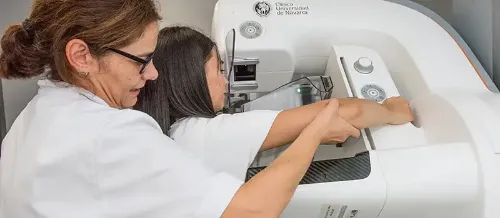Paget's disease of the breast
"The experience of the medical team in diagnosing Paget's disease in the breast is essential because it is often confused with a benign skin lesion and is not treated in a timely manner".
DR. FERNANDO MARTÍNEZ
CODIRECTOR. BREAST PATHOLOGY AREA

Paget's disease of the breast is a rare cancer (1-3 % of the cases of breast cancer) that affects the skin of the areola-nipple complex.
In more than 80% of the cases of patients with Paget's disease, there is a ductal carcinoma of the breast in situ that underlies the lesion and must be treated appropriately.
The cancer cells known as Paget's cells are a telltale sign of Paget's disease in the breast. These cells are found in the epidermis (top layer) of the skin of the nipple and areola.
Most cases occur in women, and especially in postmenopausal women in their 50s and 60s, although it can also occur in men.

What are the symptoms of Paget's breast disease?
The symptoms of Paget's disease of the breast are often confused with the symptoms of some benign skin conditions, such as dermatitis or eczema.
Paget's disease causes redness, pain and scaling of the skin that covers and surrounds the nipple. At first, these symptoms tend to come and go.
Over time, they usually get worse and may include:
- Itching, tingling or burning sensation.
- Pain and tenderness.
- Flaking and thickening of the skin.
- Flattening of the nipple.
- Yellowish or bloody discharge from the nipple.
The most common symptoms are:
- Scaling of the nipple skin.
- Itching and redness of the nipple.
- Flattening or retraction of the nipple.
Do you have any of these symptoms?
You may have Paget's disease of the breast
How is Paget's disease diagnosed in the breast?

In its initial presentation, Paget's disease of the breast is often diagnosed as eczema, as it appears to be a lesion with erythematous scaling of the nipple.
Diagnosis of Paget's disease usually begins with a complete history of the patient and a physical examination of the breasts.
The characteristic lesion is a reddish (erythematous) and scaly plaque with irregular edges. It is usually a single lesion located on the nipple or very close to it, on the mammary areola. The size of the lesion is usually between 3 to 15 cm.
If there is suspicion of disease, a mammography and ultrasound will be performed. If the results of the imaging studies are inconclusive, an MRI may be required. The final diagnosis will be obtained through the results of a biopsy.
How is Breast Paget's Disease treated?
The therapeutic approach that is assessed in patients with Paget's disease in the breast will depend, fundamentally, on whether a breast carcinoma exists in addition to Paget's disease.
If there is an absence of breast cancer, if Paget's disease does not have multiple foci (multicentric) or if the underlying disease is relatively close to the areola-nipple complex, the patient may be a candidate for breast conserving surgery.
Chemotherapy given before surgery may allow some patients with underlying disease to opt for breast-conserving surgery, avoiding a mastectomy.
In addition, after breast conserving surgery, various reconstructive techniques can be performed on the breast to achieve favorable aesthetics and a better quality of life for patients.
For those with an underlying malignancy or multicentric disease, mastectomy remains the standard treatment. In these cases an intraoperative sentinel node biopsy can be performed to assess whether the disease has spread to the lymph nodes...
After surgery, most of these patients receive radiation therapy, administered throughout the breast. If nodal involvement is confirmed when the tissue removed in surgery is analyzed, it may be necessary to also administer chemotherapy.
Where do we treat it?
IN NAVARRE AND MADRID
The Breast Pathology Area
of the Clínica Universidad de Navarra
The Clinic is the most technologically advanced private hospital in Spain in a single center. For this reason, the Breast Pathology Area is able to facilitate diagnosis 24 hours after performing the tests and begin treatment in approximately 48 hours.
Our nursing staff is specialized in breast pathology and performs patient education, telephone follow-up and advice, before and after surgery.
What diseases do we treat?
- Breast Cancer
- Inflammatory diseases of the breast
- Benign tumors: fibrocystic mastopathy, breast fibroadenoma, etc.
- Risk lesions that require vigilance

Why at the Clinica?
- Prestigious professionals who are international references.
- Speed in the diagnosis and treatment of breast problems.
- Specialized nursing for the best care of our patients.










